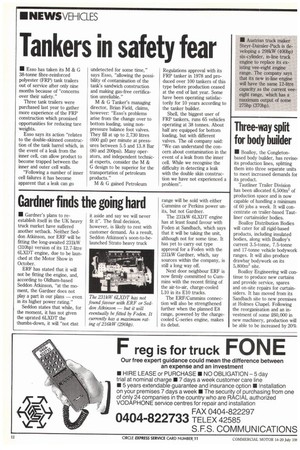Tankers in safety fear
Page 10

If you've noticed an error in this article please click here to report it so we can fix it.
• Esso has taken its M & G 38-tonne fibre-reinforced polyester (FRP) tank trailers out of service after only nine months because of "concerns over their safety."
Three tank trailers were purchased last year to gather more experience of the FRP construction which promised opportunities for reducing tare weights.
Esso says its action "relates to the double-skinned construction of the tank barrel which, in the event of a leak from the inner cell, can allow product to become trapped between the inner and outer cell walls.
"Following a number of inner cell failures it has become apparent that a leak can go undetected for some time," says Esso, "allowing the possibility of contamination of the tank's sandwich construction and making gas-free certification unreliable."
M & G Tanker's managing director, Brian Field, claims, however: "Esso's problems arise from the change over to bottom loading, using nonpressure balance foot valves. They fill at up to 2,730 litres (600 gal) per minute at pressures between 5.5 and 13.8 Bar (80 and 200psi). Many operators, and independent technical experts, consider the M & G design to be superior for the transportation of petroleum products."
M & G gained Petroleum Regulations approval with its FRP tanker in 1978 and produced over 100 tankers of this type before production ceased at the end of last year. Some have been operating satisfactorily for 10 years according to the tanker builder.
Shell, the biggest user of FRP tankers, runs 65 vehicles operating at 38 tonnes. About half are equipped for bottom loading, but with different valves. The oil company said: "We can understand the concern about contamination in the event of a leak from the inner cell. While we recognise the difficulty in detecting a leak with the double skin construction we have not experienced a problem".














































